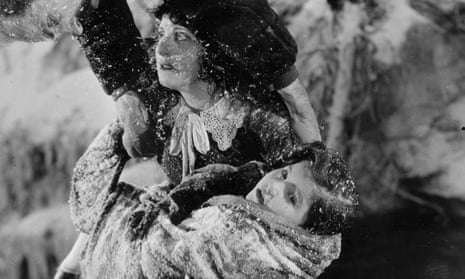Lassie Lou Ahern, who has died aged 97, enjoyed a substantial career as a child actor in 1920s Hollywood, and was one of the last surviving performers from the silent film era.
She made her debut aged three, in Hal Roach’s first full-length movie, an adaptation of The Call of the Wild (1923), and soon was regularly cast in Charley Chase comedies and as the object of rescue in the popular serials of Helen Holmes. In pictures such as Webs of Steel (1925), Ahern and Holmes carried out their own dangerous stunt work. She appeared in productions by independent producers (The Dark Angel for Samuel Goldwyn, Hell’s Highroad for Cecil B DeMille, Robes of Sin for William Russell, all in 1925), and features at major studios (John Ford’s now lost film Thank You and Excuse Me starring Norma Shearer, also 1925), before landing a contract with Universal in the mid-1920s.
There, Ahern had her own dressing room with a star on the door. A clothing line was named after her (“Lassie Lou Classics”), and her name and image were used to endorse such brands as Sunkist oranges, Buster Brown shoes and Jean Carol frocks.
She found her biggest success in the epic Uncle Tom’s Cabin (1927), landing the part of Little Harry over the hundreds of boys who auditioned for the role. The film was shot largely on location on the Mississippi river; Ahern appeared in the sequence featuring the escape across the ice floes and won excellent notices. The movie took more than a year and half to make, and ended up the third most expensive 20s Hollywood production, after Ben Hur: A Tale of the Christ (1925) and Old Ironsides (1926), and like those films it lost money at the box office.

She was cast in the rare Jewish-themed drama Surrender (1927) and as an Arab girl in The Forbidden Woman (1927), before appearing opposite the rising child star Frankie Darro in Little Mickey Grogan, her swansong in silent pictures, as the street urchin Susan Dale.
She was born in Hollywood, the daughter of Elizabeth (nee Wilson) and Fred Ahern. Her father was a real estate agent who had the actor Will Rogers as a client. After meeting Lassie and her older sister, Peggy, Rogers encouraged Ahern to take his daughters to the Hal Roach studios to be cast in parts calling for children, and soon they earned ancillary roles in the Our Gang series.
It was a spate of proto-gangster films in the late 20s that led Fred, alarmed by the rising depiction of violence, to take his daughters out of pictures. Instead, he opened a dance studio, Ahern’s Allied Arts, a few blocks away from MGM, which, besides ballet and tap, taught acrobatics, rope tricks and music skills. Between 1932 and 1939, Lassie and Peggy Ahern toured the world together as dancers (and were marvellous on screen in Hollywood Party, 1937). Their act broke up when each sister decided to marry.
While Peggy retired permanently from performing, Lassie returned to Hollywood in 1941 with her husband Johnny Brent, a former Dixieland drummer whom she had married in 1938, and who was employed as a musician for studio orchestras. She danced in City of Missing Girls (1941) and in the early musicals Donald O’Connor made at Universal (Top Man and Mister Big in 1943 and Patrick the Great in 1945), and had a bit part in George Cukor’s Gaslight (1944). Her half-brother Fred also went in the film industry, notably as a production designer for Alfred Hitchcock.
When Ahern returned to the screen decades later, it was on television, in small parts in episodes of The Odd Couple, Love, American Style, and other popular series. In middle age she worked as a travel agent and for more than 30 years taught dance. Even after decades of relative obscurity, Ahern was still winning new fans for her silent film work, and efforts are being made to restore an original 35mm nitrate copy of Little Mickey Grogan found in film archives in Paris.
I conducted an extended interview with her in 2013 for the journal Film International, and she told me: “It’s gratifying to experience such interest from around the world. Fan letters, especially from Germany and Spain, still arrive at my mailbox at a rate that amazes me.”
Johnny died in 1972. Ahern is survived by their children, Cary, Debra and John.

Comments (…)
Sign in or create your Guardian account to join the discussion